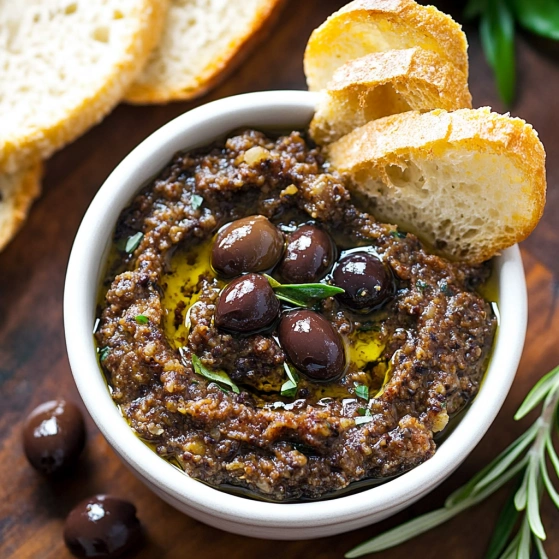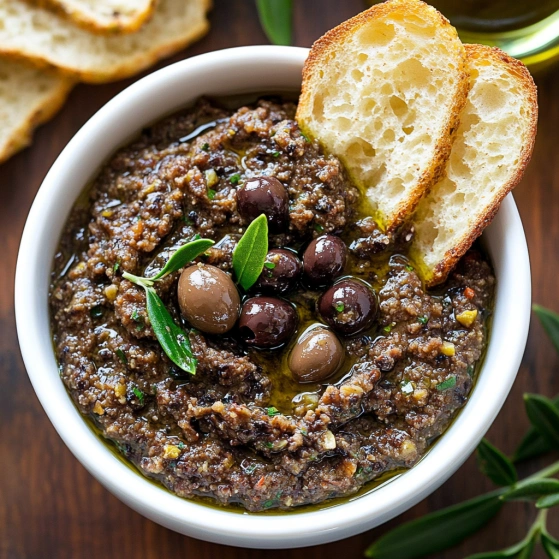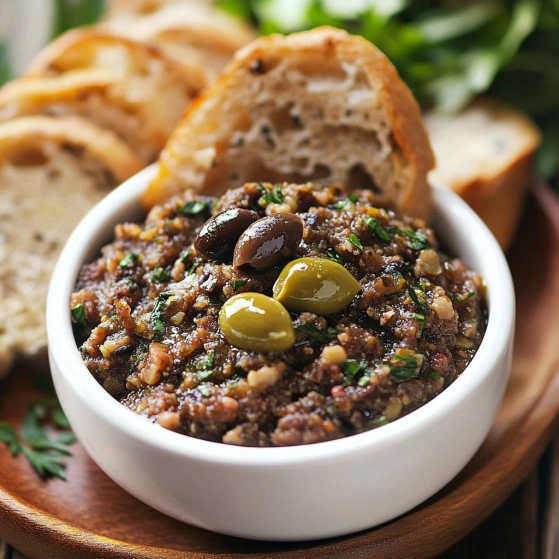 Pin it
Pin it
This Mediterranean olive tapenade transforms humble olives into an elegant appetizer that will transport you straight to the French coastline. Whether spread on crusty bread or dolloped onto pasta, this versatile condiment adds bold flavor to any dish with minimal effort.
I first created this tapenade for an impromptu dinner party when I needed something impressive but easy. The guests couldn’t believe something so flavorful came together so quickly, and now it’s my signature appetizer for gatherings of all sizes.
Ingredients
- Manzanilla olives: Bring a bright, slightly tangy flavor that balances the richer olives
- Kalamata olives: Provide the classic Mediterranean depth and slight fruitiness
- Fresh parsley: Adds color and herbaceous notes that lighten the overall flavor profile
- Garlic cloves: For essential pungent flavor, look for firm heads with no sprouting
- Olive oil: Creates the smooth texture select extra virgin for best flavor
- White wine vinegar: Adds brightness without overwhelming acidity
- Dijon mustard: Works as an emulsifier while adding subtle complexity
- Dried oregano: Brings traditional Mediterranean herb flavor; use Greek oregano if possible
- Kosher salt: Enhances all the flavors; coarse salt works best
- Fresh cracked pepper: Adds gentle heat; grind just before using
Step-by-Step Instructions
- Gather Ingredients:
- Collect all ingredients and measure them out before beginning. This ensures nothing is forgotten and makes the process seamless.
- Prep the Food Processor:
- Fit your food processor with the standard blade attachment and ensure the bowl is completely dry to prevent watery tapenade.
- Combine Ingredients:
- Add both types of olives, chopped parsley, garlic cloves, olive oil, white wine vinegar, Dijon mustard, and dried oregano to the food processor bowl all at once.
- Pulse to Desired Consistency:
- Use short pulses rather than continuous processing to maintain some texture. Stop every few pulses to scrape down the sides of the bowl with a rubber spatula. Continue until everything is well minced but still has some small chunks for texture.
- Season and Taste:
- Add a small pinch of kosher salt and several grinds of black pepper. Pulse briefly to incorporate, then taste. Adjust seasonings if needed remembering that olives already contain salt.
- Transfer and Garnish:
- Spoon the finished tapenade into a serving bowl and top with additional fresh chopped parsley for color and fresh flavor.
 Pin it
Pin it
My mother always insisted on using two types of olives in tapenade for balanced flavor. When I was growing up, she would make large batches during olive season in France, and the kitchen would fill with the most intoxicating aroma of garlic and herbs. That memory makes this recipe especially meaningful to me.
The Perfect Texture Secret
The key to exceptional tapenade is finding the right consistency. Traditional Provençal tapenade should have some texture rather than being completely smooth like a paste. I recommend using the pulse function on your food processor with about 8 to 10 quick pulses. This creates small bits that provide interest when eating but allows the mixture to spread easily. If you process too long, you will lose the distinct olive character and end up with something more like a puree.
Storage and Shelf Life
Tapenade improves with time as flavors meld together. Store it in an airtight container in your refrigerator for up to one week. For best results, press a piece of plastic wrap directly onto the surface before sealing to prevent discoloration from air exposure. The olive oil may solidify slightly when cold, so remove the tapenade about 20 minutes before serving to allow it to come to room temperature and regain its spreadable texture.
 Pin it
Pin it
Creative Serving Ideas
While traditionally enjoyed on crusty bread or crostini, tapenade is incredibly versatile. Try stirring a spoonful into hot pasta for an instant sauce, dollop onto baked potatoes, use as a sandwich spread instead of mayonnaise, or even use as a topping for grilled fish or chicken. For a lovely appetizer platter, serve alongside hummus, roasted red peppers, and feta cheese with an assortment of breads and crackers. My family particularly enjoys it tucked into deviled eggs for an unexpected twist on a classic.
Frequently Asked Questions
- → How long does homemade olive tapenade last in the refrigerator?
Homemade olive tapenade will last up to 1 week when stored in an airtight container in the refrigerator. The olive oil helps preserve it naturally, but for best flavor, consume within 5-7 days.
- → Can I freeze olive tapenade?
Yes, you can freeze olive tapenade for up to 3 months. Store it in a freezer-safe container with a thin layer of olive oil on top to prevent freezer burn. Thaw overnight in the refrigerator before serving.
- → What can I substitute for white wine vinegar?
You can substitute white wine vinegar with red wine vinegar, champagne vinegar, or fresh lemon juice. Each will provide a slightly different flavor profile but will maintain the necessary acidity for the tapenade.
- → Besides bread, what else can I serve with olive tapenade?
Olive tapenade is versatile and pairs well with many foods. Try it as a spread on sandwiches, mixed into pasta, dolloped on roasted vegetables, as a topping for grilled tofu or tempeh, or as part of a Mediterranean-inspired bowl.
- → Can I make olive tapenade without a food processor?
Yes, you can make tapenade without a food processor by finely chopping all ingredients by hand using a sharp knife. For a more rustic texture, use a mortar and pestle. While more labor-intensive, these methods can yield excellent results with a bit more texture.
- → How can I adjust the flavor if my tapenade is too bitter?
If your tapenade tastes too bitter, try adding a teaspoon of maple syrup or a small amount of finely chopped sun-dried tomatoes. You can also incorporate more fresh herbs or a squeeze of lemon juice to balance the flavors.
